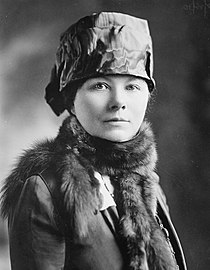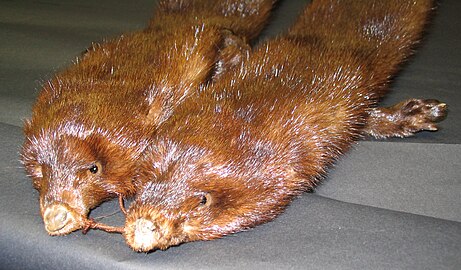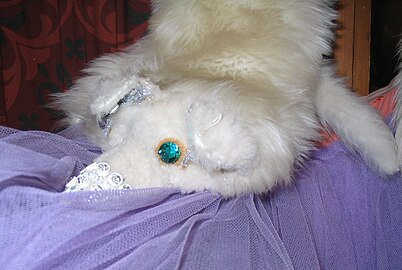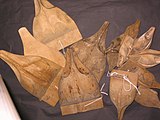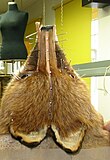Fur necklace
A fur necklace , also known as a fur necklace, is a fur scarf made in an approximated animal shape , which was very fashionable until the 1960s, usually with a head, paws and tail. For einfellige necklaces made of skins of the family of mustelids ( mink , sable and polecat fur ) the designation was Strangler common. Necklaces made from smaller skins usually consist of two or four individual skins.
Small, single- skin fur animal scarves were referred to as Kollets in an Austrian specialist book in 1928 . Unlike Germany was understood in Austria necklace or Kolier generally a "neck fur, however, in contrast to the tightly sewn collar, can be worn separately." In the meantime, the term "necklace" for the animal shape is also common in Austria.
Fur necklaces were rarely offered in Europe in recent years.
Collier types
As a rule, the necklaces, fur shawls in animal shape, were made of fox skins, mink skins, stone and pine marten skins or ermine skins. If other types of fur were used, they often imitated one of these high-quality fur types through appropriate fur finishing and processing. The silver fox fur in particular was often imitated. In 1942, for example, a specialist book describes the elaborate production of a skunk fox, a necklace the size and appearance of a fox, but made from two or three skunk skins cut into one another.
Single-skin necklaces are clamped to the tail or in the skin with a necklace clip located in the head of the skin, or they are held together with a necklace chain covered with trimmings. Smaller necklaces made of marten or similar skins are usually made of two skins that are attached with the heads upwards, with a short bar next to each other. In order to lengthen the necklace and make it more attractive, two more, also completely worked out skins are often placed on the bottom. This is also closed with a necklace chain and hook, with a hook and eye or a trimmed push button. Especially with the fox necklace, the front paws, which are a bit annoying when worn, were occasionally left out.
The single-skin necklace is usually worn around the neck, with the fur head on the chest. More often, especially in the warmer months of the year, it is simply placed over the forearm, in the somewhat extravagant version with a fox placed over one shoulder or hanging from one shoulder. In the case of necklaces made of several skins arranged in pairs, it is thought that the heads of the fur lie on the wearer's back, to the right and left of the neck, the main part hangs down lengthways across the front of the chest. Another possibility is to loop the two necklaces around each other at the front instead of closing them next to each other.
history
- Queen Wilhelmina of the Netherlands with a silver fox necklace
The predecessor of the fur necklace was the so-called "flea fur" (main article → flea fur ). A flea fur or flea fur, coming from Italian, also called Zibellino ("little sable"), was a small necklace made of ermine, sable, polecat or marten fur with an elaborate head, tail and paws, often decorated with precious stones Late Middle Ages and especially during the Renaissance came into vogue in European aristocratic circles and among the very wealthy bourgeoisie. It was worn slung over the shoulder or occasionally on a chain on the belt. Dorothee Backhaus mentions "Contenance" as another name for the flea fur. Allegedly, the function of the flea fur should be to attract annoying insects such as fleas and to distract them from the wearer's body. Since the fleas react to body heat and not to hair, there are some indications that the fur, which is mainly to be carried in the hand, was only subsequently assigned the effect of a flea trap.
Up until the second half of the 19th century there was no fur fashion in the true sense of the word. Furs were mainly the inner lining or trimmings of textiles, especially men's outerwear. In the 1890s, fashion magazines first appeared fashion pictures devoted entirely to fur clothing. It was around this time that the first furs to be worn with the hair on the outside appeared, but they did not yet play a role in everyday fashion. A very big topic, however, was the fur set, consisting of a fur hat , fur scarf, fur gloves and, of course , a fur muff . At the end of the 19th century, fur was no longer just a trim item reserved for luxury. The characteristic of the fur fashion of that time lay, beginning particularly strikingly, between 1906 and 1907, “in the entire use of the fur animal with head, claws and tail as fur decoration. Fashion was soon not satisfied with one fur animal, but demanded several, with heads as large as possible and as many tails and claws as possible on a fur cover next to the muff. The pinnacle of this fashion exaggeration was represented by the fur animal heads, which also emit "noises" and whose snouts were prevented from biting with a muzzle ”, the latter an idea that an artistic jeweler in diamond-studded design had already at the time of flea fur. The fur trimmings made of rabbit fur were also offered in great variety as girls' clothing. These accessories were often provided with “exposed heads and tails”, especially the many parts made from ermine fur. A popular motif was an ermine or white fox muff with the ermine or fox peeping out and sticking out their forepaws.
Thanks to its rarity and popularity, a silver fox fur was still extremely valuable at the beginning of the 20th century. That hardly changed at first when Canadians Charles Dalton and Robert Oulton managed to breed silver foxes on a larger scale as demand increased at the same time. Silver fox scarves and capes, but above all silver fox necklaces, were very much in fashion and could be seen at every festivity. They were by no means only worn outdoors, but also at festivities such as balls, visits to the opera, etc. Since the price was high, the fur refiners and furriers created imitations from various cheaper types of fur. It went so far that you imitated the silver-gray guard hairs of the silver fox by the so-called peak light hair in black colored red foxes in American opossum , skunks, long-haired rabbit fur and rabbit fur einklebte. Among other also were wolverine fur , raccoon fur , known as Flying Dog skins and the skins of domestic dogs tipped.
Not every lady wore such opulent fashion accessories. At the same time, the much smaller marten necklaces, polecat necklaces and ermine necklaces were also popular, with the increase in mink breeding especially mink necklaces. In particular, the pelts of male mink were occasionally so large that a single-skinned "strangler" could be made from them, so smaller pelts are also cut ("cut into") to form a larger one. The term strangler, which was actually common at the time, gives an idea of how tight the part was on the neck. - For a mink necklace, for example, one usually took two large mink skins to be worn next to each other. Often the necklace was lengthened by two further skins, also provided with heads, paws and tails, which were placed on the top two.
Philipp Manes , the fur commissioner murdered in Auschwitz and biographer of the fur industry, wrote in 1928:
“The strangler also gets a lot of attention. We had the opportunity to see the Arthur Wolff-Berlin collection, which has almost a hundred models - you can buy a complete small necklace for just a few marks - and shows pieces made from it, including marten, mink and skunks. We all want nothing more than to buy these bits and pieces everywhere again. If the fair helps us to do this, if we convince the German furriers that it is up to them alone to use clever propaganda to inspire customers in the small town for this delightful little jewelry, then we will have our quiet time with double success bridge. The furrier will then do a lot more than if he just adjusted to the large objects. "
Mane's appeal to his colleagues in the industry was not unheard of, a fur necklace was soon part of the wardrobe of almost every woman, not just the middle class. At another point Philipp Manes mentions that in Germany only young girls wore beech marten necklaces until the First World War , "only after the war did other circles enjoy the noble animal, you had to pay over 40, - [Mark] for it". In 1942 a furrier discovered that until then the silver fox had been worn almost exclusively as an animal-shaped necklace.
The London tobacco merchant Francis Weiss wrote in his report on the ups and downs of fur prices (the silver fox price had meanwhile dropped from £ 500 to 50 to 60 shillings): “Shortly before the Second World War , silver fox stoles came to the USA as“ street girls -Uniform “in fashion. As a result, no decent woman dared to wear a silver fox in public for the next few decades. "
This was only partially the case for Germany. The war prevented the import of valuable types of fur due to a lack of foreign currency, a German woman wore German fur anyway, that was mainly the inexpensive but not particularly famous rabbit , but there was also the bred silver fox. More and more silver fox farms had sprung up, and silver fox fur became the favorite fur of the Hitler era. Film stars could be admired privately and on the screen with voluminous, shoulder-hugging capes and encouraged imitation. When the German troops occupied Denmark and Norway, the soldiers brought their brides and wives one or two silver fox skins bred there, which the local furrier then usually combined with a necklace with a head, tail and paws or a wavy collar with paws or a simple shawl collar or a fur stole worked. With the currency reform in 1948, the era of long hair fashion ended in Germany.
In the mid-1950s, the great era of fur necklaces came to an end. The fashion journalist Marie Louise Steinbauer even said that most of the usual "four mink skins, two of them tied head to head in the neck of the wearer" were not the result of the new prosperity of the economic miracle in the Federal Republic, but only survived the war unscathed . She continued: “At the level of the collarbones, two more minks bit into the hides of the other two and now either hung loosely over the wearer's bosom, or they were intertwined so as not to be carried away by the wind. These ties were very popular with women, whose husbands had achieved something, but not a whole coat for the expensive ”.
Not worn or otherwise unsightly necklaces were allowed by the furrier to collar and small fur Ties fashion . Often it was enough, for example with double-skin mink necklaces, to connect the two skins behind the cut heads with a polish seam, to separate the front paws and to round off or bevel the lower ends instead of the paws in order to obtain a chic, “double-skin” tie
In the time of the fox necklaces there were also fox boas , long, narrow fur scarves that also had a fox head like a necklace as a one-sided finish. Around the 1980s, inexpensive boas made from fox tails were sold in large numbers, often with such a head attached.
Single-skin sable necklace ( Redfern , 1904)
Esther Pohl Lovejoy (1869–1967) with a Kolinsky necklace
Philanthropist Anne Morgan with an arctic fox necklace (around 1915)
Queen Mum with a double-headed fox necklace, visiting troops during World War II (1942)
Eartha Kitt with a multilayered marten necklace (1962)
Head of a dyed blue fox necklace ( Revillon Frères , around 1960)
Lambskin necklace, imitating white fox, in the collection of the Düsseldorfer Schauspielhaus (2012)
Red fox necklace , redesigned to cover a theater costume jacket (2005)
processing
Initially, a fox necklace was usually made as large as possible. In order to make all the fur visible, the underside was lined, artfully decorated with a floral silk lining , with borders or frills. The taste had already changed in the 1930s and it was now found, at least with the valuable noble foxes, more beautiful if the fox consisted of fur all around, even if it became smaller as a result. It was now of the opinion, “It is not the size that gives the piece a noble effect, but the emphatically natural appearance. For the owner of a necklace made in this way, it is pleasantly warm to wear, especially in cool weather, as the soft dewlap is turned towards the face ”.
Small fox skins, especially the arctic fox , were enlarged by galoning , or sewing in narrow leather or strips of fabric. Earlier fantasy shapes, mostly semicircular or adapted entirely to the neckline, had also gone out of fashion. The eyes, which were made of (now artificial) precious stones on flea furs much earlier , were more of a fashionable peculiarity at the time. This overall simpler processing has been preserved to this day, also for the European red foxes, which are not considered to be noble foxes.
In 1956, 12 furrier hours, 3 manual sewing hours and 3 machine sewing hours were estimated for making a mink necklace from four skins.
The working of a red fox necklace
After mostly the front paws have been removed and the fox has been worked to the desired length by leaving it out, the head is worked out in the moistened state. The basis is a pre-made fur necklace head shape , either reusable made of wood or made of paper mache . The ears are cut out in an ellipse and stretched with pins and then cut to size; if necessary, the side of the ear with little hair is covered with suitable fur; In the past, foals or similar pieces of fur were often used for this. The eyeholes are either sewn shut or under-sewn with elongated glass eyes, in the latter case the eyelids must not be trimmed. If the eye holes are too large, they are closed with a hand seam starting from the back. The wire at the eyes is pierced through a round piece of leather and twisted behind the leather to form a flat spiral. The two pieces of leather prepared in this way are sewn with large stitches behind the eye openings, the higher side of the eye towards the back. According to the wooden or cardboard shape, the ears are sewn in with the little hairy side facing forward and the lower jaw, which was previously thinly cut, is fitted onto the shape. A wooden head shape is prepared for covering by wrapping a few layers of tissue or newspaper around it. The well-moistened head is pulled onto the paper wrapping coated with glue (formerly dextrin , now mostly other elastic adhesive) and the ears and especially the underlaid eyes are carefully aligned with pins and cardboard strips. Then the fur is stretched while moist, the paws must lie exactly in the later break. The peeled-off fur is leveled, the front paws are reinserted if they have not already been brought further forward with the help of several elliptical cuts before tensioning, which is much nicer but quite laborious. If the front paws were left in their natural place, the head section would be longer and therefore heavier and the necklace would annoyingly slip. Then the possible wooden form is removed and the glass eyes are attached. For eyes inserted afterwards, a round, not oval shape is usually chosen. The head is padded and a special fox clip, with which the finished animal will later bite its own tail or rump, is attached. The necklace is sewn up in the stomach or, in the case of small foxes, padded. Then it is stretched smooth again overnight.
Glass eyes
The glass eyes required for the necklaces were previously made in Czechoslovakia, especially in and around the towns of Gablonz ( Jablonec nad Nisou ) and Morchenstern ( Smržovka ). Since the entire production of the artificial eyes was in the hands of Germans displaced after the Second World War, a large part of this industry moved to Austria, especially to Tyrol. Here not only was domestic demand met, but also exported abroad on a larger scale.
The glass eyes were, at least in the middle of the 20th century, made in all sizes and colors, round or as oval corner eyes, painted or burned, with wire or eyelet and others.
Artificial noses
Noses made of rubber, leather, sheet metal and celluloid
For noses that might no longer exist, there used to be a large selection of finished rubber , metal, cardboard, celluloid and leather noses. The furrier also modeled his noses himself from the kneadable material offered, if possible together with leather (preferably scrap leather from glove makers or bag makers). Today the only thing that helps, if available, is to replace a correspondingly larger, suitable piece of fur with one with an intact nose. - It is not possible to find out with certainty what the furrier apprentices or journeymen chewed their noses on. There are still furriers alive who assure that this was part of their job when making a fur necklace. (As of 2011) Nevertheless, there is some evidence that this was one of the numerous jokes that journeymen and masters in all industries have with the apprentices. It is enough to water the nose for a few hours before processing.
In 1939, a furrier needed an entire page of a magazine to teach his colleagues how to properly make artificial noses so that the fox actually looks like a fox afterwards , but not a monkey, a herring or any other antediluvian creature. Back then, and probably more today, it was difficult to buy skins with flawless, undamaged heads . Replacement, which was offered in the form of sheet metal, leather and hard rubber , was not a nice replacement, but only a makeshift aid in peak business hours, when it is not possible to make a putty nose despite all the effort . In his day, the so-called tail putty was still available for purchase in the fur ingredient trade . Noses that are only damaged are, after the furrier has repaired them while they are soaked, coated on the head shape with the putty and modeled with a possibly warmed knife and then painted. A stone-hard nose could also be made from a mixture of pieces of newspaper dissolved in hot water, joiner's glue and plaster, which then only had to be colored according to nature.
If the head has no nose at all, the place where the nose should be located is cut free from the hair. A hole is poked in the middle with the furrier's heated awl, the grunt . This is where the first tail putty comes in, which sticks to the cardboard head mold. The remaining hair is singed off with a flame and the putty is warmed up before further putty is applied in the size of the future nose. With a dampened knife and a damp nail, a nose that is as realistic as possible is formed, which is then also painted with iron varnish. By using the putty, it is possible to make an opossum, a skunks or a badger nose; because these have a different shape than the fox nose. Don't say to anyone: “The customers don't care whether their skunk bull has a real Skunks or a fox nose!” - What the lay customer says can come out in the other ear, because we need to know better.
See also
Web links
Individual evidence
- ↑ Alexander Tuma: Pelz-Lexikon. Fur and rough goods. XXI. Tape. Verlag Alexander Tuma, Vienna 1951. Search word Würger
- ↑ sales letter of Heinz Pape, fur Strangler fabrication , Leipzig 1935th
- ^ Alexander uma jun .: The furrier's practice . Julius Springer, Vienna 1928, p. 195-197, 262 . → Table of contents .
- ↑ a b Alexander Tuma: Pelz-Lexikon. Fur and Rough Goods, Volume XIX . Alexander Tuma, Vienna 1950, p. 56, keyword “Kolier, also necklace” .
- ^ Information from the Viennese master furrier Johann Jouja v. 2nd May 2018.
- ↑ a b Fritz Hempe: Handbook for furriers . Verlag Kürschner-Zeitung Alexander Duncker, Leipzig 1932, pp. 152, 217. → Table of contents .
- ^ Dorothee Backhaus: Breviary of fur . Keysersche Verlagsbuchhandlung, Heidelberg / Munich 1958, p. 28 (→ table of contents) .
- ^ Tawny Sherrill: Fleas, Fur, and Fashion: "Zibellini" as Luxury Accessories of the Renaissance. In: Robin Netherton, Gale R. Owen-Crocker (eds.): Medieval clothing and textiles. Volume 2. Boydell Press, Woodbridge et al. 2006, ISBN 1-84383-203-8 , pp. 121-150 (English).
- ↑ Eva Nienholdt: Fur fashions of the 20th century . Chapter VIII of the Series of Articles: Fur in European Clothing. Prehistoric time to the present. In: The fur trade. No. 5, 1957, p. 213.
- ↑ Anna Municchi: Ladies in Furs 1900–1940 . Zanfi Editori, Modena 1992, p. 59 (English), ISBN 88-85168-86-8 .
- ↑ Konrad Haumann: Costume-historical foray through the centuries. In: The tobacco market. March 12, 1943, p. 7.
- ↑ "Le.": CL Motz on the lace of fur skins. In: The tobacco market. No. 7, Leipzig, February 14, 1936, p. 5.
- ^ Philipp Manes : The German fur industry and its associations 1900-1940, attempt at a story . Berlin 1941 Volume 2. Copy of the original manuscript, p. 167 ( G. & C. Franke collection ).
- ^ Philipp Manes : The German fur industry and its associations 1900-1940, attempt at a story . Berlin 1941 Volume 2. Copy of the original manuscript, p. 27.
- ^ Francis Weiss: Up and Down . In Winckelmann Pelzmarkt , Winckelmann Verlag, Frankfurt am Main, issue 317, January 2, 1976, p. 1.
- ^ A b Marie Louise Steinbauer, Rudolf Kinzel: Marie Louise Pelze . Steinbock Verlag, Hannover 1973, pp. 118, 152–153.
- ^ E. Unger: Materials science for leather and fur workers . Teaching Practice Series of the Max Mehner Further Education School , Volume 10, Alfred Hahn's Verlag, Leipzig 1910, p. 23.
- ↑ a b Without indication of the author: The change of the fox necklace. In: The tobacco market. No. 47, Leipzig, November 20, 1936, p. 5.
- ^ Author collective: Der Kürschner. Technical and textbook for the furrier trade. 2nd, revised edition. Vocational training committee of the central association of the furrier trade (ed.), JP Bachem publishing house, Cologne 1956, p. 356. → Book cover and table of contents .
- ^ Fritz Hempe: Handbook for furriers. Verlag Kürschner-Zeitung Alexander Duncker, Leipzig 1932, pp. 87–99.
- ↑ a b Alexander Tuma: Pelz-Lexikon. Fur and Rauhwarenkunde, Volume XX . Alexander Tuma, Vienna 1950, p. 162–163, keyword “fur ingredients” .
- ^ Josef Novak: Basic concepts of skinning. Österreichischer Gewerbeverlag, Vienna 1949, p. 22.
- ↑ Fritz Bellwinkel: The brown nose. In: Kürschner-Zeitung. Verlag Alexander Duncker, Leipzig September 1940, p. 357.
- ^ Fritz Bellwinkel-Hannover: Artificial noses. In: Kürschner-Zeitung. 56. Vol. 11, Verlag Alexander Duncker, Leipzig April 11, 1939, pp. 354-356.





